
Silene nutans is a flowering plant in the genus Silene, most commonly known as Nottingham catchfly.
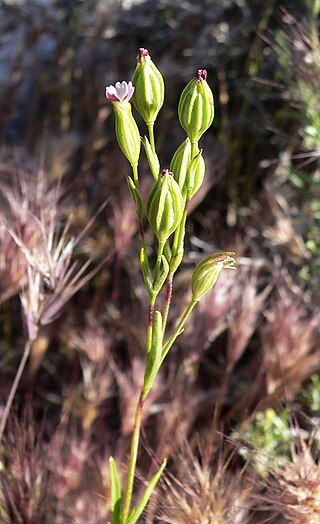
Silene antirrhina is a species of flowering plant in the family Caryophyllaceae known by the common names sleepy silene and sleepy catchfly. It is native to the Americas and has been introduced to Europe.
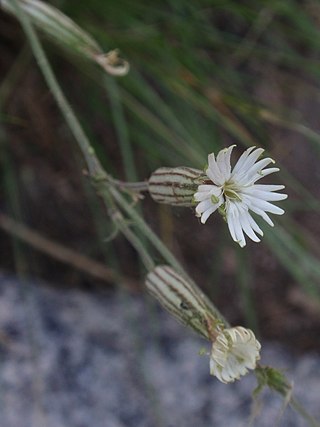
Silene bernardina is a species of flowering plant in the family Caryophyllaceae known by the common name Palmer's catchfly.
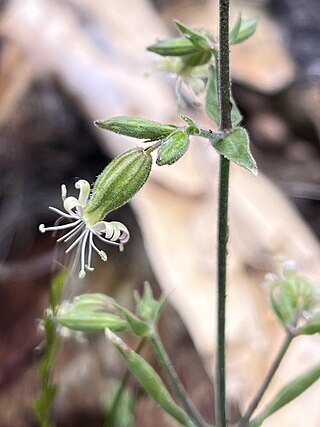
Silene bridgesii is a species of flowering plant in the family Caryophyllaceae known by the common name Bridges' catchfly.

Silene campanulata is a species of flowering plant in the family Caryophyllaceae known by the common names Red Mountain catchfly and bell catchfly. It may be a synonym of Silene greenei.

Silene douglasii is a species of flowering plant in the family Caryophyllaceae known by the common name Douglas's catchfly.

Silene invisa is a species of flowering plant in the family Caryophyllaceae known by the common names red fir catchfly and short-petaled campion.
Silene marmorensis is a rare species of flowering plant in the family Caryophyllaceae known by the common names Marble Mountain catchfly, Marble Mountain campion, and Somes Bar campion. It is endemic to the southern Klamath Mountains of northern California, where it grows in mountain woodlands and forests. It is a perennial herb producing several stems and shoots from a woody, branching caudex and thick taproot. The hairy, glandular stems grow erect to a maximum height near 40 centimeters. The lance-shaped leaves are a few centimeters long and are borne in pairs, the lowermost drying early. The inflorescence is a terminal cyme of flowers at the top of the stem, and some flowers may occur in the leaf axils. Each flower has a hairy, veined calyx of fused sepals. The flowers bloom at night, the five pinkish or green-tinged petals opening at the tip of the calyx.
Silene nuda is a species of flowering plant in the family Caryophyllaceae known by the common names western fringed catchfly and sticky catchfly.

Silene occidentalis is a species of flowering plant in the family Caryophyllaceae known by the common names western catchfly and western campion.
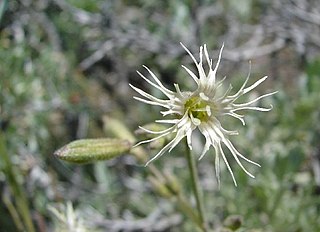
Silene oregana is a species of flowering plant in the family Caryophyllaceae known by the common names Oregon silene, Oregon campion and Oregon catchfly. It is native to the western United States, including the Great Basin, where it grows in habitat such as sagebrush and forests. It is a perennial herb growing from a woody caudex and taproot, sending up an erect, mostly unbranched stem which may be 70 centimeters tall. The lance-shaped leaves are up to 8 centimeters long around the caudex, and shorter farther up the stem. Flowers occur in a terminal cyme and sometimes in leaf axils. Each flower is encapsulated in a hairy, glandular calyx of fused sepals. The five petals are creamy white or pink-tinged in color and each has four to six long, fringelike lobes at the tip.
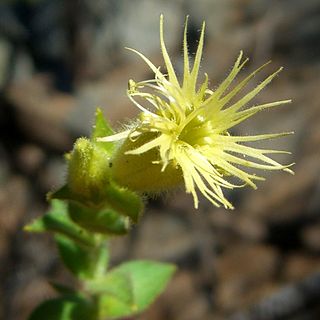
Silene parishii is a species of flowering plant in the family Caryophyllaceae known by the common name Parish's catchfly. It is endemic to southern California, where it is known from several of the local mountain ranges, including the San Bernardino, San Gabriel, and San Jacinto Mountains. It grows in rocky, forested habitat, sometimes in the alpine climates of the higher peaks. It is a perennial herb growing from a woody, branching caudex and taproot, sending up several decumbent or erect stems 10 to 40 centimetres tall. The oppositely arranged leaves line the stems, the largest ones located at the middle of each stem. Leaves are lance-shaped to nearly oval and up to 6 centimetres long. They are thick and leathery, and sometimes glandular and sticky. Each flower is encapsulated in a tubular calyx of fused sepals which may be nearly 3 centimetres long. It is greenish with ten veins and a coating of glandular hairs. The five petals are yellowish in colour and each has about six long, fringelike lobes at the tip.

Silene sargentii is a species of flowering plant in the family Caryophyllaceae known by the common name Sargent's catchfly. It is native to the western United States, where it is known from the mountain ranges straddling the California-Nevada border east of the Sierra Nevada. It is also known from one disjunct occurrence in central Washington. It grows in rocky mountain habitat in subalpine and alpine climates. It is a perennial herb growing from a woody, branching caudex and taproot, sending up several decumbent or erect stems and shoots. It grows no more than about 20 centimeters tall, often taking a clumpy form. The fleshy leaves are widely lance-shaped and a few centimeters in length, most of them occurring around the caudex. Each flower is encapsulated in a hairy, glandular calyx of fused sepals which has stark purple veining. The petals are white to deep pink and each has two or more rounded or pointed lobes at the tip.

Silene scouleri is a species of flowering plant in the family Caryophyllaceae known by the common names simple campion and Scouler's catchfly.
Silene suksdorfii is a species of flowering plant in the family Caryophyllaceae known by the common names Suksdorf's silene, Suksdorf's catchfly and Cascade alpine campion. It is native to the Pacific Northwest of the United States, where it occurs from Washington and Idaho to northern California. It is mainly an alpine species, growing in the talus of high mountain slopes. It can also be found below the tree line in forested subalpine habitat. It is a squat perennial herb producing several erect stems from a leafy, woody caudex. It generally takes a clumpy form. The stems grow up to 10 or 15 centimeters tall and are hairy in texture, with glandular, sticky areas on the upper parts. The leaves occur in tufts around the caudex. They are fleshy and coated in soft hairs. Solitary flowers arise on erect peduncles. Each is encapsulated in an inflated calyx of fused sepals, which is starkly purple-veined and has purplish glandular hairs. The petals are white or purple-tinged and have two lobes at their tips and appendages at their bases.

Silene lanceolata is a rare species of flowering plant in the family Caryophyllaceae known by the common names Kauai catchfly and lanceolate catchfly. It is endemic to Hawaii, where it is known only from Oahu, Molokai, and Hawaii, having been extirpated from Kauai and Lanai. It is threatened by the degradation of its habitat and it is a federally listed endangered species of the United States.

Silene polypetala is a rare species of flowering plant in the family Caryophyllaceae known by the common names eastern fringed catchfly and fringed campion. It is native to Georgia and northern Florida in the United States. It is threatened by the loss and degradation of suitable habitat. It is a federally listed endangered species of the United States.

Spiranthes diluvialis is a rare species of orchid known as Ute lady's tresses. The species name diluvialis means "of the flood". It is native to the western United States, where there are scattered, mostly small occurrences in the states of Colorado, Idaho, Montana, Nebraska, Nevada, Utah, Washington, and Wyoming. An occurrence was recently discovered in southern British Columbia. The plant faces a number of threats to its existence. It is a federally listed threatened species of the United States.

Silene regia is a species of flowering plant in the family Caryophyllaceae known by the common name royal catchfly. It is native to the central United States. A perennial herb, it grows from a fleshy taproot and has several erect stems growing up to 1.6 meters tall. The leaves are lance-shaped to oval and up to 12 centimeters (4.7 in) long, becoming smaller farther up the stem. The inflorescence is an array of many flowers at the top of the stem. The elongate tubular calyx of sepals is up to 2.5 centimeters (0.98 in) long and has 10 longitudinal veins. The lobes of the bright red corolla are 1 to 2 centimeters long.
Silene seelyi is a species of flowering plant in the family Caryophyllaceae known by the common names Seely's catchfly and Seely's silene. It is endemic to Washington state in the United States, where it is limited to the Wenatchee Mountains of Chelan and Kittitas Counties.

















